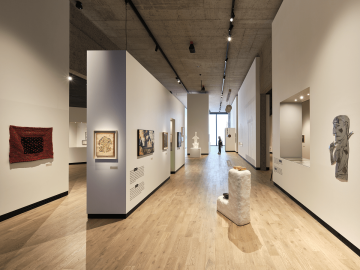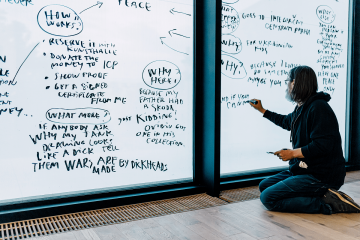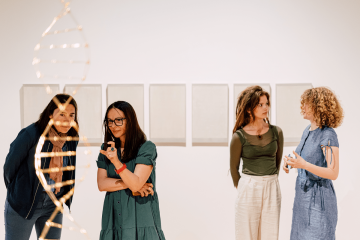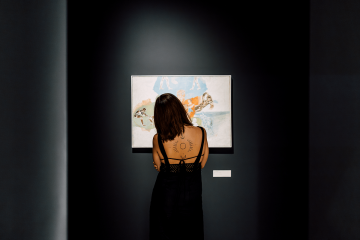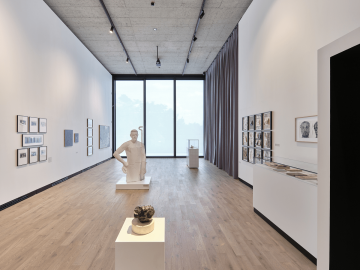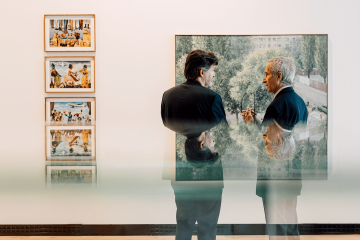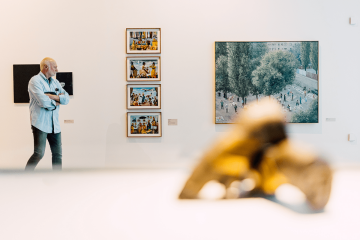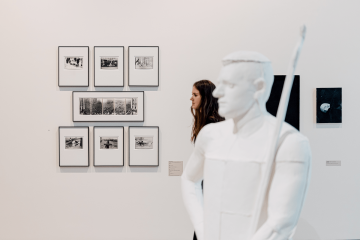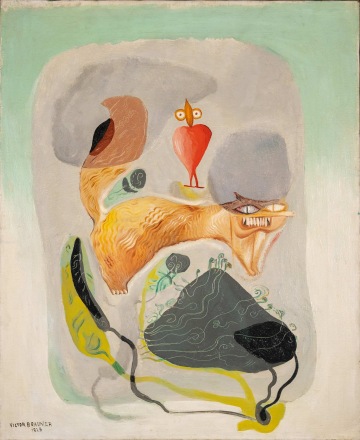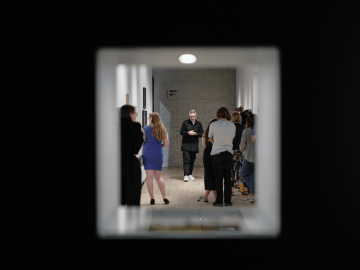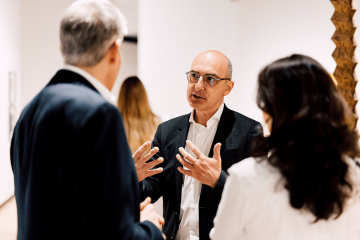LOST IN THE MOMENT THAT FOLLOWS. The Ovidiu Șandor Collection
150 works, 79 artists: we're presenting the first large-scale exhibition of the Romanian art scene in the Czech Republic
LOST IN THE MOMENT THAT FOLLOWS
Ways of Collecting: The Ovidiu Șandor Collection
9/6 2023—10/9 2023
Gallery 3
Curator: Tevž Logar
Exhibition series concept: Christelle Havranek
Please note that the exhibition ends on day sooner, i.e. on Sunday, September 10, instead of the originally announced end date on Monday, September 11, due to the partial reconstruction of Gallery 3. Thank you for your understanding.
Exhibiting artists: Dragoș Alexandrescu, George Apostu, Hans Arp, Aurel Baranga, Ion Bârlădeanu, Ioana Bătrânu, Marius Bercea, Horia Bernea, Ștefan Bertalan, Brassaï, Constantin Brâncuși, Geta Brătescu, Victor Brauner, Michele Bressan, André Breton, Filip Brunea-Fox, André Cadere, Ion Călugăru, Mircea Cantor, Andrei Chintilă, Victor Ciato, Radu Comșa, Lena Constante-Brauner, Roman Cotoșman, Sandu Darie, Jean David, Marcel Duchamp, Max Ernst, Harun Farocki, Constantin Flondor, Adrian Ghenie, Bogdan Gîrbovan, Ion Grigorescu, Octav Grigorescu, Jacques Hérold, Marcel Iancu, Pavel Ilie, Jean Isidore Isou, Vasilij Kandinskij, Matei Lăzărescu, Gherasim Luca, Ana Lupaș, Pierre Mabille, Victor Man, Henri Matisse, Max Hermann Maxy, Hortensia Mi Kafchin, Joan Miró, Alex Mirutziu, Florin Mitroi, Ciprian Mureşan, Vlad Nancă, Gellu Naum, Paul Neagu, Ioana Nemeş, Constantin Nisipeanu, Mihai Olos, Miklós Onucsán, Sașa Pană, Andrei Pandele, Christian Paraschiv, Paul Păun, Jules Perahim, Dan Perjovschi, Pusha Petrov, Mihai Plătică, Lea Rasovszky, Robert Rius, Eugen Roșca, Șerban Savu, Decebal Scriba, Arthur Segal, Hedda Sterne, Yves Tanguy, Doru Tulcan, Tristan Tzara, Andrei Ujică, Andra Ursuța, Ilarie Voronca.
Invited artists for new commissions: Alex Mirutziu, Ciprian Mureşan, Dan Perjovschi.
-
The title of the exhibition, Lost in the Moment That Follows, comes from a quote by the founder of surrealism, André Breton, and reflects on the relationship between the past, the present, and the future. The exhibition at Kunsthalle Praha is the Czech Republic’s first extensive presentation of the Romanian art scene, from modernism to the present. All exhibited works come from the diverse collection of Romanian collector and philanthropist Ovidiu Șandor, founder of the Art Encounters biennale of contemporary art in Timișoara and holder of the French title of the Knight of the Order of Arts and Letters. A significant portion of his collection is on display until Sunday, September 10, 2023.
-
The Ovidiu Șandor Collection focuses on Romanian art, tracing in particular the artistic practices, movements, and ideas that offer meaningful reflections on our common recent history. The exhibition features nearly 150 works by 79 artists, structured by the exhibition curator Tevž Logar into five chapters exploring several topical themes.
in contemporary art: identity, nature, space, the body, and memory. The exhibition presents various types of artistic media, from painting and drawing to installation and sculpture to photography and video.
-
Șandor’s collection has a relatively broad historical scope, spanning from the early twentieth century to the present. The interwar avant-garde is exemplified especially by works by Constantin Brâncuși, Victor Brauner, and Brassaï, while the postwar avant-garde is represented by the works of, among others, André Cadere and Ana Lupaș, and contemporary post-revolutionary art by the works of Mircea Cantor, Ciprian Mureșan, and Ioana Nemeș. These prominent names from the Romanian art scene are complemented by equally well-known figures of international art, including Jean David and Max Ernst.
-
The title of the exhibition comes directly from a quote by the famous French writer André Breton, the founder and main theorist of surrealism, an artistic movement that is strongly represented in Ovidiu Șandor’s collection. Curator Tevž Logar explains the exhibition’s title: “The original quote by Breton concerns time—the relationship between the past, the present, and the future. It is also very closely related to the exhibited artworks from Ovidiu Șandor’s collection, especially in the sense that this exhibitioin is not only a retrospective but also a dialogue with the present.” Breton’s original quote reads: “The important thing is that man is lost in time, in the moment that immediately precedes him—which only attests, by reflection, to the fact that he is lost in the moment that follows.”
-
The exhibition is a continuation of the series Ways of Collecting, which was first presented to the public at Kunsthalle Praha with the exhibition Midnight of Art: Karel Babíček’s Collection (July 1–September 30, 2022). Christelle Havranek, chief curator and creator of the series concept, adds: “With this exhibition series, we are highlighting the activity of collecting, which—although often ignored—is an integral part of the artistic ecosystem. In the Czech Republic especially, where for many years art collections were accessible to the public only through state institutions, the role of private collectors remains somewhat of a mystery. Who collects what, and why? What is the relationship between art and collecting? And are artists themselves collectors? Our series aims to offer answers to all these questions and many others.”
-
The exhibition catalogue contains a wealth of images and information, including Logar’s curatorial text, an interview he conducted directly with collector Ovidiu Șandor, and an essay by the renowned art historian Bernard Blistène, who was director of the Centre Pompidou in Paris from 2013 to 2021.
© Jan Malý, Vojtěch Veškrna
About Ovidiu Șandor
He is the founder and current chairman of the Art Encounters Foundation, which is responsible for the contemporary art biennale of the same name in the city of Timișoara in western Romania. He is also an art collector, an active player in the field of culture and education, and, in his own words, an active citizen. He is on the board of the Conservation Carpathia Foundation, an NGO dedicated to preserving the virgin forests in Romania’s Făgăraș Mountains, with the goal of turning the area into the largest nature park in Europe.
“For my art collection, it is not only recent history and contemporary events that are crucial but also the history of the twentieth century. Particularly from the perspective of an Eastern European country, where schools presented us with a very abridged version of history, art is one of the ways to rediscover the history of our own country and our broader cultural identity,” comments Șandor, highlighting one of the key aspects of building his art collection.
According to the exhibition’s curator, Tevž Logar, in the regional context of southeastern Europe, Șandor’s collection is an exemplary case wherein the actions of a particular collector have a positive impact on improving conditions for the entire local art ecosystem—and not “merely” through the purchasing of works by Romanian artists but also through the long-term program of the aforementioned Art Encounters Foundation, which functions as an open platform for contemporary art, connecting Timișoara with other international art spaces.
“When people hear the word collecting, they immediately imagine that it’s something that requires a lot of money. But it actually requires a lot of time. It doesn’t even occur to anyone how much time collecting takes. So, I think time is a very important part of collecting,” says Șandor, who started out as a collector of rare Romanian maps. In December 2022 the French government named him a title of the Knight of the Order of Arts and Letters (Chevalier of the Ordre des Arts et des Lettres) for his significant contributions to culture.
The Collection as a Living Organism
How is the Ovidiu Șandor Collection structured, and what new things does it bring? According to curator Tevž Logar, the collection rests on a trio of historical pillars that contest each other. The first pillar is represented by the historical avant-garde, which is further developed by the works of the postwar Romanian neo-avant-garde (i.e., postwar art until the end of the 1980s). The third pillar is the art that began to emerge after the Romanian Revolution of December 1989, which, given its course and number of victims, ranks among the most violent of the anti-communist upheavals that took place in the late 1980s in Central and Eastern Europe.
“This third pillar is in some sense the most complex of the three, in part because it was at this time that the collection began to provide direct support to the generation of artists who began their artistic creation after the revolution. During their personal and professional development, artists of this generation witnessed the total transformation of the social and political panorama, and this was directly expressed in the formation of their own positions as artists,” writes Tevž Logar in the exhibition catalogue.
According to Logar, visitors should think of the presented collection not as a burial ground for objects but rather as a living organism. The collection is constantly expanding with new acquisitions that often reveal the similarities between the conceptual and formal interests of contemporary artists and those of their predecessors.
It was for this reason as well that the curator approached three contemporary Romanian artists to enter a dialogue with the existing collection, add new impulses and layers, responding to the specific spaces of Kunsthalle Praha and the context of the Prague exhibition. This initiative resulted in the creation of, for example, a new drawing entitled Peace by Dan Perjovschi, whom local audiences may know from his drawings on the walls inside the National Technical Library. Visitors will also be able to see a sculpture by Ciprian Mureşan entitled Echoes, which contains a built-in camera obscura, or the performance Intervention Is Enough Evidence. Finally. by Alex Mirutziu.
SELECTION OF THE ARTWORKS
TEVŽ LOGAR
is an independent curator, editor, and author who collaborates with various art galleries, institutions, collections, and publishers. He has curated or co-curated a number of group and solo exhibitions and cooperated with institutions such as: the Venice Biennale (pavilions of Slovenia, North Macedonia, and Kosovo); Muzeum Sztuki in Łódź; Fondazione Sandretto Re Rebaudengo in Torino; the Ljubljana Biennial of Graphic Arts; the Museum of Modern and Contemporary Art in Rijeka; James Gallery in New York; Cooper Gallery in Dundee; American University of Beirut; CAC Genève in Geneva; Kontakt Collection in Vienna, and many others. In 2023 he was appointed chairman of the NLB Group Art Council. From 2009 to 2014 he was the artistic director of the Škuc Gallery in Ljubljana. He is a co-founder of the Ulay Foundation in Amsterdam, where he now sits as a member of its advisory board. He lives in Rijeka, Croatia.
OVIDIU ȘANDOR
is the president of the Art Encounters Foundation, the initiator of the Art Encounters Biennial of Contemporary Art in Timișoara, an art collector, and an engaged citizen with a prolific career as a real estate developer. He graduated from the Polytechnic University of Timișoara in 1995 and earned a doctorate in computer science at the KTH Royal Institute of Technology in Stockholm in 2010. He rose to prominence as an entrepreneur with the development of the real estate project City Business Centre Timișoara, an endeavor that garnered international recognition with a series of awards and nominations for architecture and energy efficiency. Șandor was also the Romanian commissioner of the europalia cultural event that took place in 2019 in various cities in Belgium. Since 2013 he has served on the Eastern European Acquisitions Committee at the Tate Modern and more recently on a similar committee at the Centre Pompidou. In addition to his involvement in culture, Șandor is active in education and started a foundation that established and runs the British International School of Timișoara, where more than 500 students have already enrolled. He is also a member of the board of the Conservation Carpathia Foundation, an NGO dedicated to preserving the virgin forests in the Făgăraș Mountains in Romania, with the goal of turning the area into the largest nature park in Europe. Șandor was named a Chevalier of the Ordre des Arts et des Lettres in December 2022 by the government of France for his cultural contributions.
© Jan Malý

